Note:
RGPR.RGPR.Note that his tutorial will not explain you the math/algorithms behind the different processing methods.
I suggest to organise your files and directories as follows:
/2014_04_25_frenke (project directory with date and location)
/processing (here you will save the processed GPR files)
/rawGPR (the raw GPR data, never modify them!)
RGPR_tutorial.R (this is you R script for this tutorial)
RGPR and set the working directoryInstall and load the RGPR-package
# install "devtools" if not already done
if(!require("devtools")) install.packages("devtools")
devtools::install_github("emanuelhuber/RGPR")
library(RGPR) # load RGPR in the current R session
Set the working directory:
myDir <- "~/2014_04_25_frenke" # adapt that to your directory structure
setwd(myDir) # set the working directory
getwd() # Return the current working directory (just to check)
If you need help about a specific function, check the documentation with either help("FUNCTION_NAME") of ?FUNCTION_NAME, example:
?traceStat
The raw GPR data are located in the directory /rawGPR. The data format is the Sensors & Software format. Each GPR data consists of
.hd) that can be opened with a normal text editor.DT1).To read the GPR data, enter
x <- readGPR(dsn = "rawGPR/LINE00.DT1") # the filepath is case sensitive!
class(x)
## [1] "GPR"
## attr(,"package")
## [1] "RGPR"
Here, we define time-zero, $t_0$ as the time at which the transmitter starts to emit the wave.
Maybe is time zero not correctly set. To get the time-zero for each traces of x use the function time0():
time0(x)
The first wave break, $t_{\mathrm{fb}}$, is estimated for each traces (it is the time of the first wave record) with firstBreak():
tfb <- firstBreak(x, w = 20, method = "coppens", thr = 0.05)
plot(pos(x), tfb, pch = 20, ylab = "first wave break",
xlab = "position (m)")
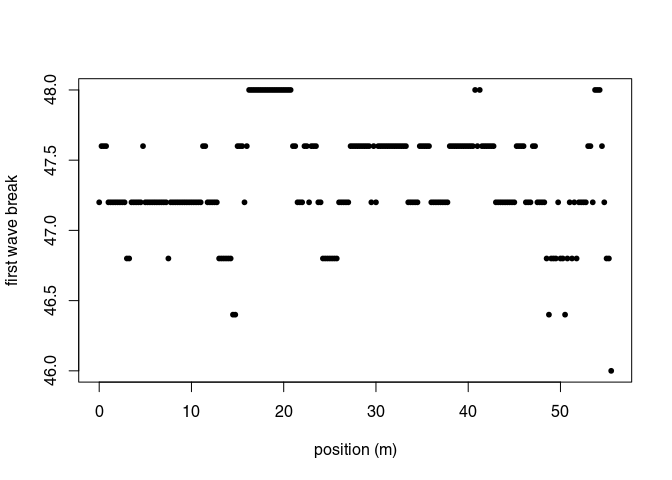
Convert the first wave break time $t_{\mathrm{fb}}$ into time-zero $t_0$ with firstBreakToTime0().
Here we define
\[t_0 = t_{\mathrm{fb}} - a/c_0\]where $a$ is the distance between the transmitter and receiver and $c_0$ is the wave velocity in the media between the transmitter and receiver (in our case, air). The value $a/c_0$ corresponds to the wave travel time from the transmitter to the receiver.
t0 <- firstBreakToTime0(tfb, x)
time0(x) <- t0 # set time0
Note that:
t0 is too noisy, you can set time0(x) <- mean(t0).x <- setTime0(x, t0) instead of time0(x) <- t0 (both are the same)Check the results (do you see the difference between time zero in red and first wave break time in blue?):
plot(x[, 15], xlim = c(0, 100)) # plot the 15th trace of the GPR-line
abline(v = tfb[15], col = "blue") # first wave break time
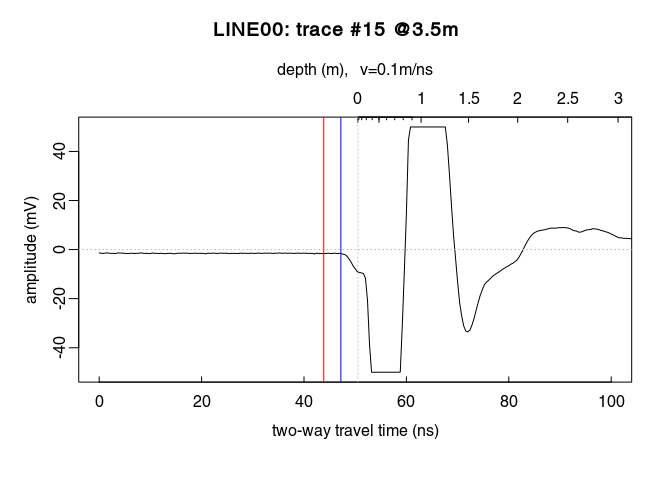
You can apply at once all the previous steps (first wave break estimation + set time-zero) with the function estimateTime0() (which has the same arguments as the functions firstBreak(), firstBreakToTime0() plus an extra argument - FUN - for function to apply to the estimated time-zero, e.g. mean(); see the documentation), i.e.:
x <- estimateTime0(x, w = 20, method = "coppens", thr = 0.05, FUN = mean)
Plot a single trace:
plot(x[, 15]) # plot the 15th trace of the GPR-line
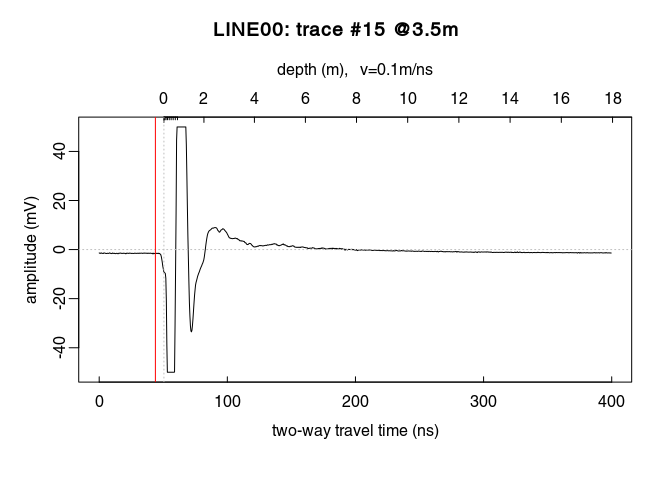
Notice how the trace samples before the first wave arrival (before $t = 0\,ns$) are slightly shifted below $0\,mV$? This shift is called direct current offset (DC-offset) and you will remove it from the data. The direct current offset is estimated on trace samples before time-zero.
Determine which samples will be used to estimate the direct current offset (i.e., the samples before the first wave arrival). Identify the samples before $t = 0\,ns$ by ploting the first $n$ samples of the traces. For example, for $n = 110$:
# plot the first 110 samples of the 15th trace of the GPR profile
plot(x[1:110, 15])
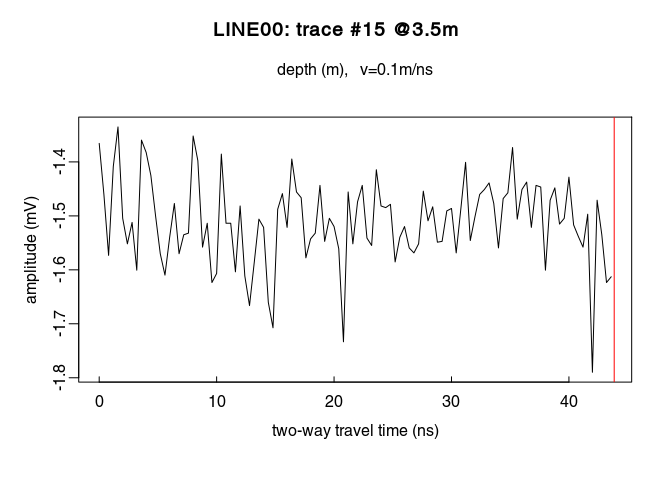
You can visualise the DC-offset on the trace plot by adding an horizontal lines (abline(h=...)) with the argument h equal the DC-offset, i.e., the mean of the first $110$ samples (mean(x[1:110,15]):
```r
plot(x[, 15]) # plot the 15th trace of the GPR-line
# add a green horizontal line
abline(h = mean(x[1:110, 15]), col = "green")
```
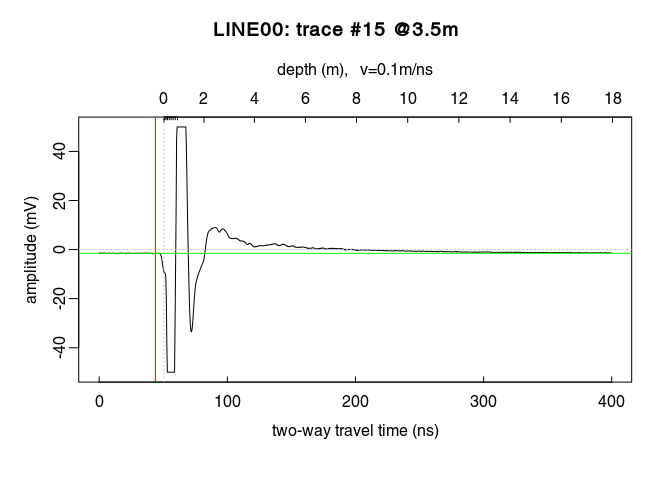
Remove the DC-offset estimated on the first n samples usind the function dcshift(). This function takes as argument the GPR object and the sample index used to estimate the DC shift (in this case, the first $110$ samples):
x1 <- dcshift(x, u = 1:110) # new object x1
Have a look at x1:
x1
## *** Class GPR ***
## name = LINE00
## filepath = rawGPR/LINE00.DT1
## 1 fiducial(s)
## description =
## survey date = 2014-04-25
## Reflection, 100 MHz, Window length = 399.6 ns, dz = 0.4 ns
## 223 traces, 55.5 m
## > PROCESSING
## 1. time0<-
## 2. dcshift//u=1:110
## ****************
Compared with x or print(x), three additional lines are displayed. The two last line show the applied processing step:
time0<-dcshift. The arguments passed to the function are listed after the double slashes //Each time a GPR object is processed with a function, the name of the function as well as some of its arguments are stored in the GPR object. This enables to track the data processing, i.e., to know exactly which processing steps where applied to the data. This is a first step toward reproducible research.
The processing steps can be extracted with the function processing():
proc(x1)
## [1] "time0<-" "dcshift//u=1:110"
To shift the traces to time-zero, use the function time0Cor (the method argument defines the type of interpolation method)
x2 <- time0Cor(x1, method = "pchip")
plot(x2)
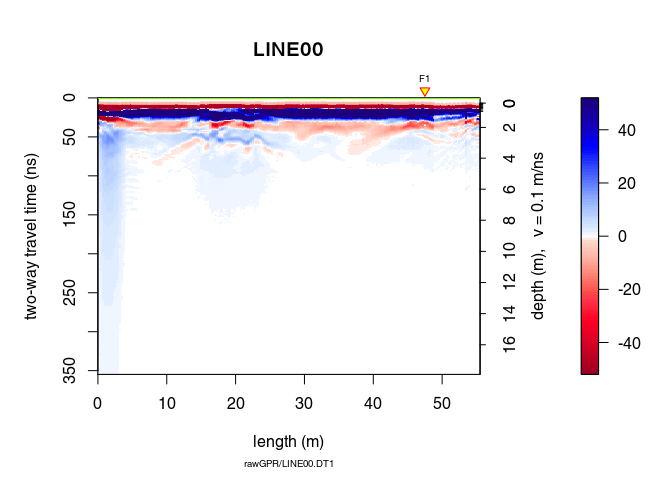
Remove the low-frequency components (the so-called “wow”) of the GPR record using:
type = "runnmed")type = "runmean")type = "Gaussian")For the two first cases, the argument w is the length of the filter in time units. For the Gaussian filter, w is the standard deviation.
x3 <- dewow(x2, type = "runmed", w = 50) # dewowing:
plot(x3) # plot the result

Can you see the difference with x1? Plot x3 - x2 to see the removed “wow”.
plot(x3 - x2) # plot the difference
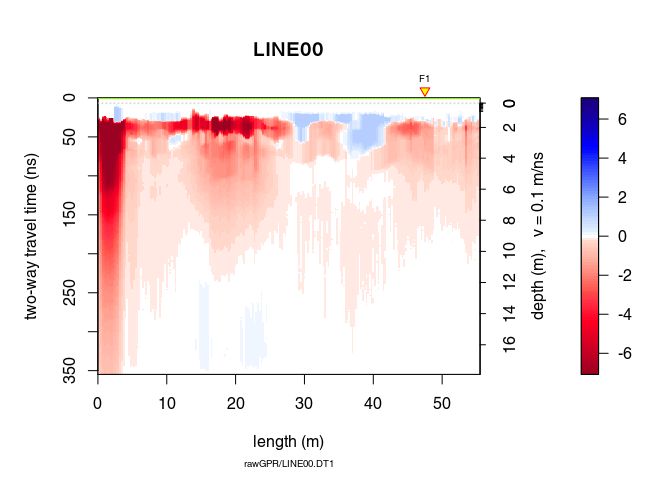
See the dewowing by comparing the traces before (blue line) and after (red line):
plot(x2[,15], col = "blue") # before dewowing
lines(x3[,15], col = "red") # after dewowing

Let’s have a look at the amplitude-frequency and phase-frequency plot (the spectrum given by the Fourier decomposition):
spec1D(x3)

## *** Class GPRset ***
## name = LINE00
## n sets = 2
## filepath = rawGPR/LINE00.DT1
## description =
## survey date = 2014-04-25
## Reflection, 100 MHz, Window length = 177.6 MHz, dz = 0.4 MHz
## 223 traces, 55.5 m
## > PROCESSING
## 1. time0<-
## 2. dcshift//u=1:110
## 3. time0Cor//method=pchip
## 4. dewow//type=runmed+w=50
## 5. spec1D//
## ****************
The curve in red is the averaged amplitude/phase over all the trace amplitudes/phases.
On the first plot, notice
Eliminate the high-frequency (noise) component of the GPR record with a bandpass filter. We define as corner frequencies at $150\,\mathit{MHz}$ and $260\,\mathit{MHz}$, and set plotSpec = TRUE to plot the spectrum with the signal, the filtered signal and the filter.
x4 <- fFilter(x3, f = c(150, 260), type = "low", plotSpec = TRUE)
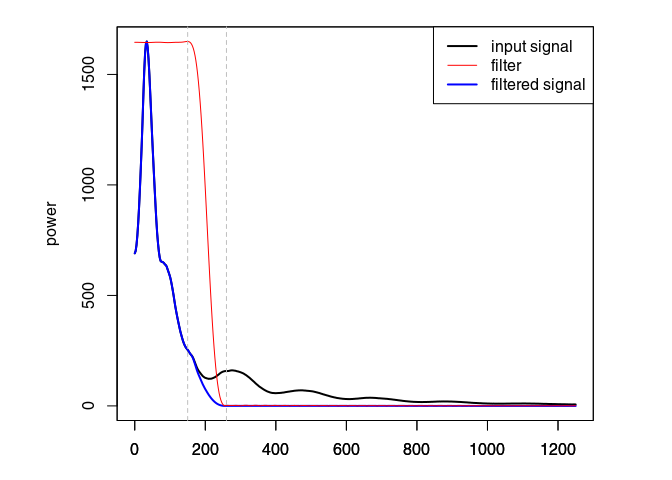
plot(x4)

Let see the difference
plot(x4 - x3, clip = 50)
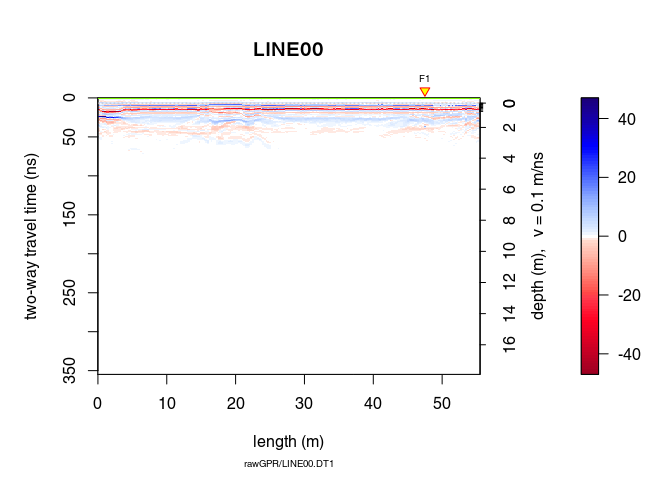
Ideally, the objective of processing is to remove the noise component without altering the signal component to improve the signal/noise ratio. When ploting the difference in processing (after - before), one should only observe the noise that is filtered out. Here, removing and attenuating some frequencies change the signal amplitude.
Apply a gain to compensate the signal attenuation. Three types of gain are available:
power gain (type = "power"):
with $\alpha = 1$ per default.
exponential gain (type = "exp"):
Automatic gain control (type = "agc"): make gain equal to the local root mean squared signal.
We will first apply a power gain and then an exponential gain. To visualise the amplitude envelope of the GPR signal as a function of time, use the function plotAmpl() as follows:
# compute the trace amplitude envelopes (with Hilbert transform)
x4_env <- envelope(x4)
# plot all the trace amplitude envelopes as a function of time
trPlot(x4_env, log = "y", col = rgb(0.2,0.2,0.2,7/100))
# plot the log average amplitude envelope
lines(traceStat(x4_env), log = "y", col = "red", lwd = 2)
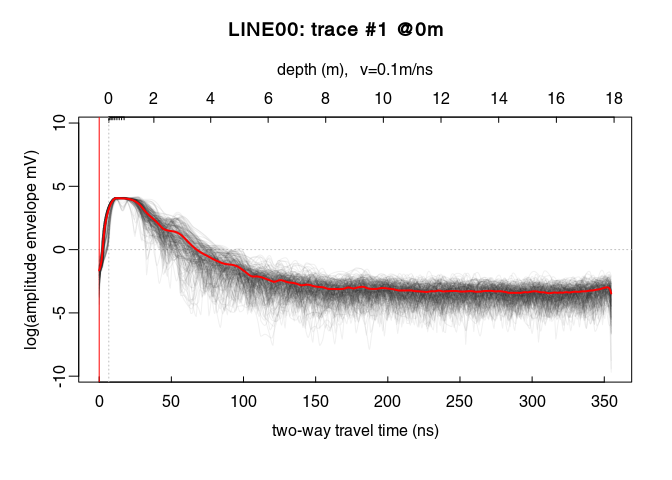
On the plot above, there is a sharp increase of the amplitude envelope at the begining of the signal. This sharp increase corresponds to the first wave arrival. Then the amplitude decreases until about $220\,\mathit{ns}$.
From $0\,\mathit{ns}$ to $20\,\mathit{ns}$ the power gain is set equal to the gain at $20\,\mathit{ns}$, i.e., $x_g(20)$ (constant value, tcst = 20). The gain is only applied up to $220\,\mathit{ns}$.
x5 <- gain(x4, type = "power", alpha = 1, te = 220, tcst = 20)
Compare the amplitude before (red) and after (green) the power gain:
plot(traceStat(x4_env), log = "y", col = "red", lwd = 2)
lines(traceStat(envelope(x5)), log = "y", col = "green", lwd = 2)

plot(x5) # how does it look after the gain?
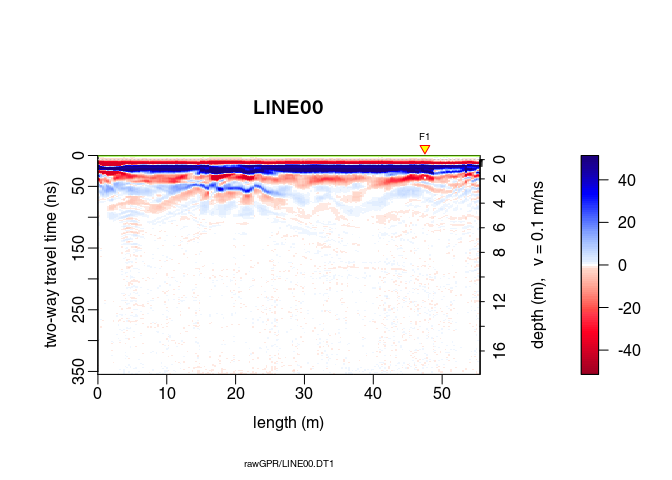
Ideally, the parameter $\alpha$ in the exponential gain should be close to the slope of the log amplitude decrease. This slope could be estimated by fitting a straight line to the amplitude decrease. After some trials, we apply the exponential gain only between $0\,\mathit{ns}$ (t0) and $125\,\mathit{ns}$ (te for $t_\mathit{end}$):
x6 <- gain(x5, type ="exp", alpha = 0.2, t0 = 0, te = 125)
plot(traceStat(envelope(x6)), log = "y", col = "blue", lwd = 2)
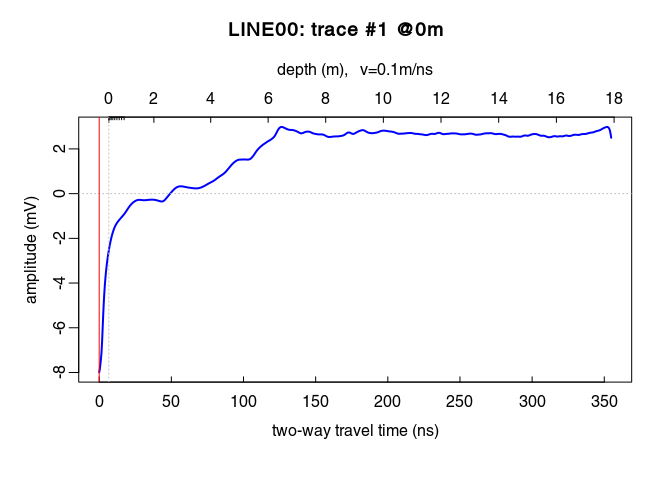
Oops! Set alpha to a smaller value!
x6 <- gain(x5, type = "exp", alpha = 0.11, t0 = 0, te = 125)
plot(traceStat(x4_env), log = "y", col = "red", lwd = 2)
lines(traceStat(envelope(x5)), log = "y", col = "green", lwd = 2)
lines(traceStat(envelope(x6)), log = "y", col = "blue", lwd = 2)
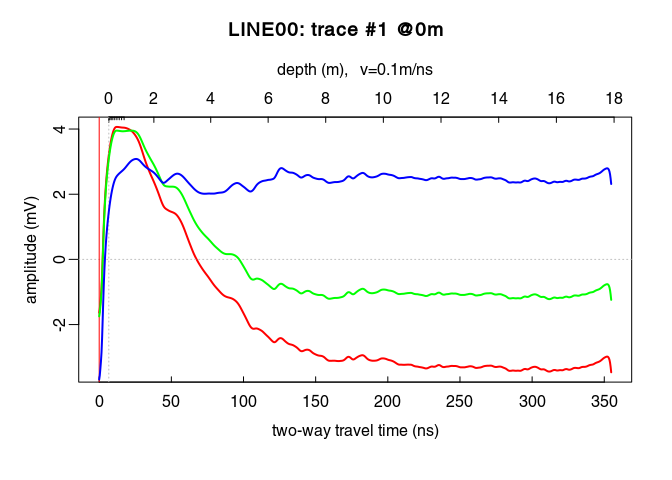
plot(x6) # how does it look after the gain?
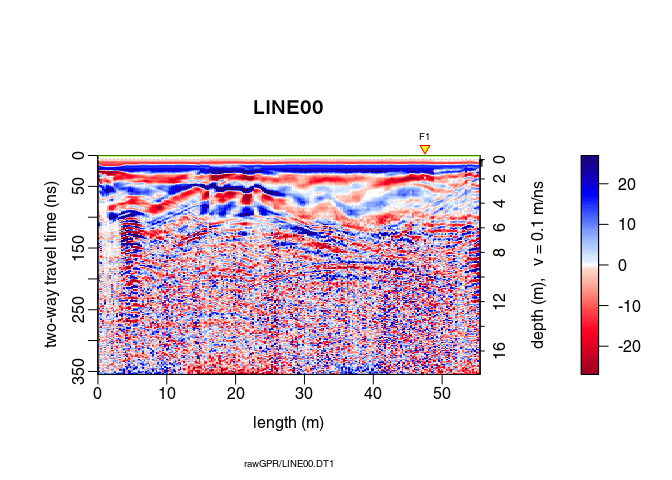
Have a look at the histogram of the values of x6
hist(x6[], breaks = 50)
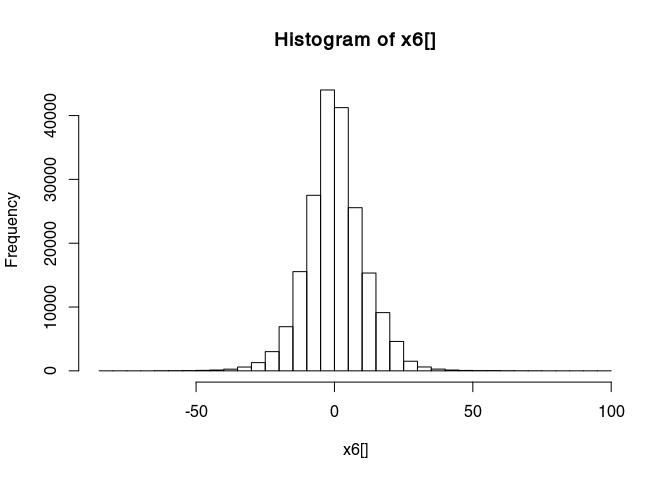
This histogram is very narrow, meaning that a lot of values are very close to zero and therefore many details are not really visible. To widen this histogram, we can transform it to make it more normally distributed with a rank-based inverse normal transformation:
x7 <- traceScaling(x6, type = "invNormal")
Histograms before and after
par(mfrow = c(1, 2))
hist(x6[], breaks = 50)
hist(x7[], breaks = 50)
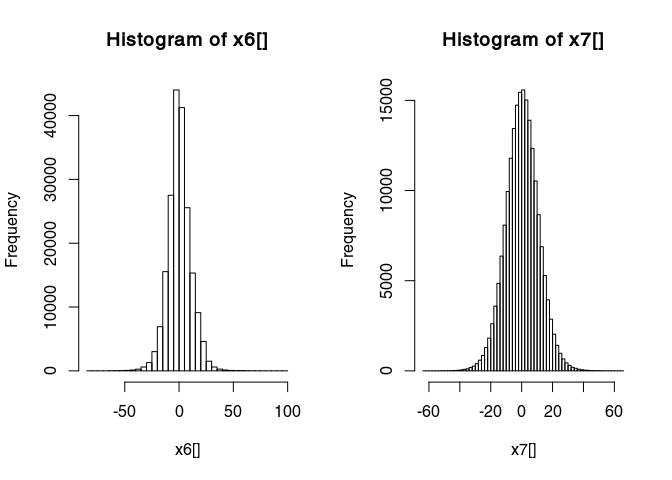 Have a look at the results of the transformation:
Have a look at the results of the transformation:
plot(x7)
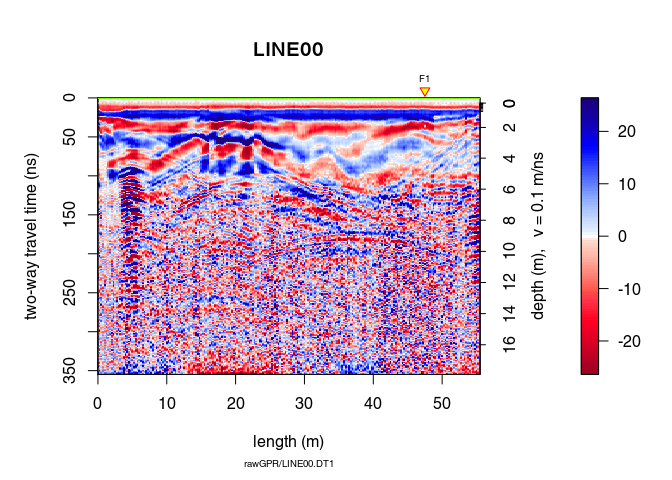
A non-linear filter to remove noise:
x8 <- filter2D(x7, type = "median3x3")
plot(x8)
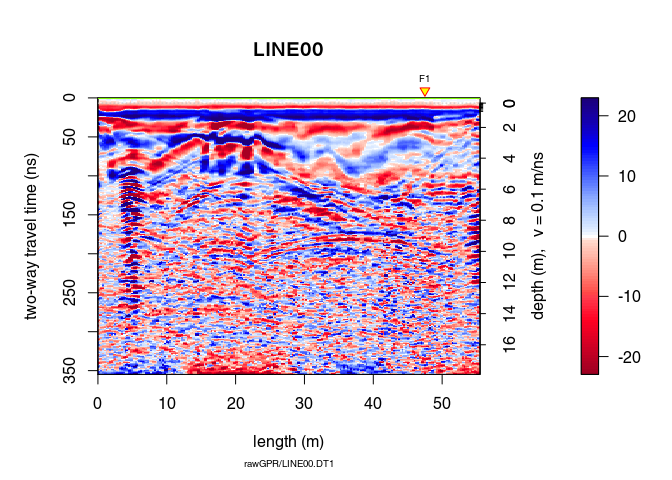
Let see the difference
plot(x8 - x7)
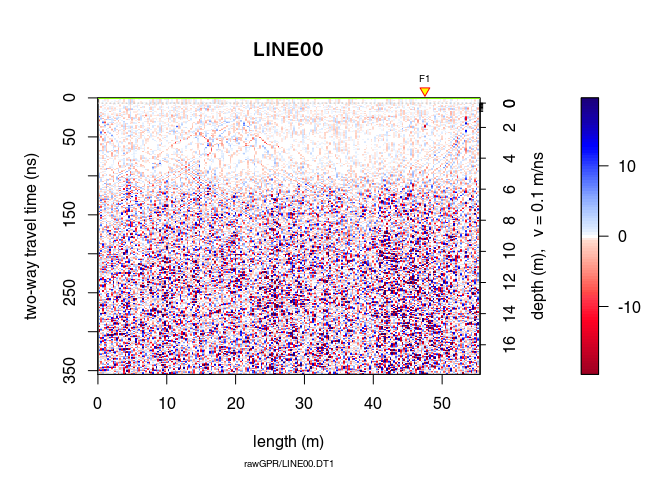
The function spec() with the argument type = "f-k returns a list containing the frequencies (f), the wavenumbers (k), the amplitude of the GPR data.
FKSpec <- spec(x8, type = "f-k")
## Soon deprecated. Use 'spec1D()' or 'spec2D()' instead
area <- list(x = c(0, min(FKSpec$wnb), min(FKSpec$wnb), max(FKSpec$wnb), max(FKSpec$wnb), 0),
y = c(max(FKSpec$fre), 800, 0, 0, 800, max(FKSpec$fre)))
lines(area, type="o")

x9 <- fkFilter(x8, fk = area)
With the f-k-filter you can successfully remove the artifacts but still the information gained is very small in this case (the quality of the raw GPR data is already bad):
plot(x9, clip = 50)

spec(x9, type = "f-k")
## Soon deprecated. Use 'spec1D()' or 'spec2D()' instead
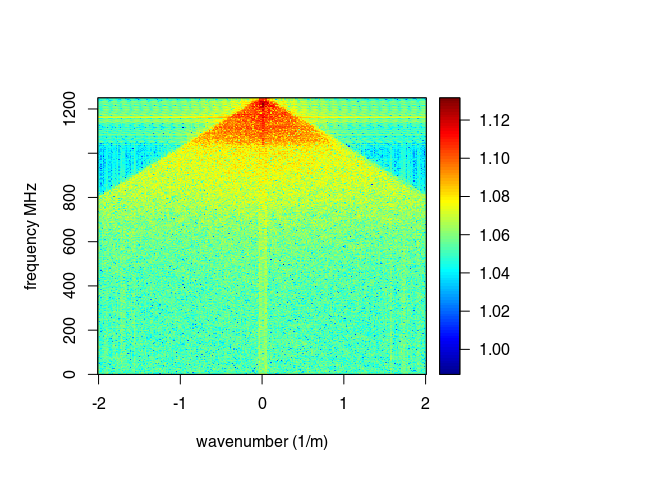
Let see the difference
plot(x9 - x8)
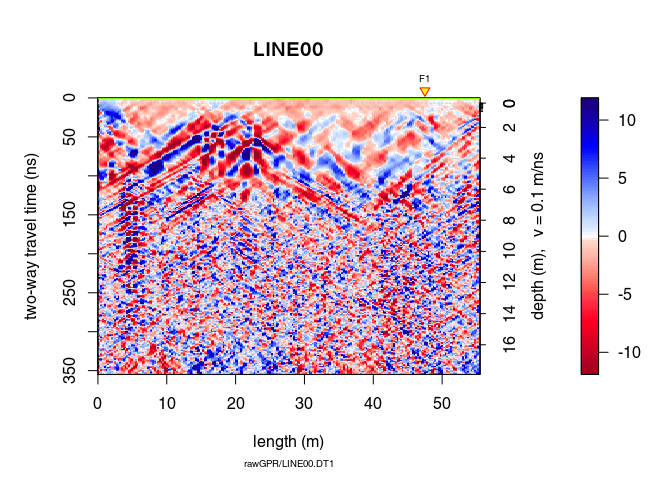
Let review the processing step applied on the GPR record:
proc(x9)
Check the help page for the function traceStat
?traceStat
x10 <- traceStat(x9, FUN = mean) # compute average trace of all traces
x10 <- traceStat(x9, FUN = median) # compute average trace of all traces
x10 <- traceStat(x9, FUN = median) # compute average trace of all traces
# compute windowed average trace (average of 20 traces)
x10 <- traceStat(x9, w = 20, FUN = median)
plot(x10)
?eigenFilter
# remove first eigenimage = keep all except the first one
plot(eigenFilter(x9, eigenvalue = c(2:ncol(x1))))
plot(eigenFilter(x9, eigenvalue = 1)) # the removed eigenvalue
# remove the first two eigenimages
plot(eigenFilter(x9, eigenvalue = c(3:ncol(x1))))
plot(eigenFilter(x9, eigenvalue = 1:2)) # the removed eigenvalue
See See Rashed and Harbi (2014) Background matrix subtraction (BMS): A novel background removal algorithm for GPR data doi: 10.1016/j.jappgeo.2014.04.022
It is a slow function!
?backgroundSub
x10 <- backgroundSub(x9, width = 21, trim = 0.2, s = 1, eps = 1, itmax = 5)
plot(x10)
plot(x10 - x9)
Save the processed GPR record into the directory /processing. Use the .rds format (this is a R internal format)
writeGPR(x9, fPath = file.path(getwd(), "processing", name(x9)),
type = "rds", overwrite = TRUE)
## File overwritten
## *** Class GPR ***
## name = LINE00
## filepath = /mnt/data/RGPR/CODE/RGPR-gh-pages/2014_04_25_frenke/processing/LINE00.rds
## 1 fiducial(s)
## description =
## survey date = 2014-04-25
## Reflection, 100 MHz, Window length = 354.8 ns, dz = 0.4 ns
## 223 traces, 55.5 m
## > PROCESSING
## 1. time0<-
## 2. dcshift//u=1:110
## 3. time0Cor//method=pchip
## 4. dewow//type=runmed+w=50
## 5. fFilter//f=150,260+type=low+plotSpec=TRUE
## 6. gain//type=power+alpha=1+te=220+tcst=20
## 7. gain//type=exp+alpha=0.11+t0=0+te=125
## 8. traceScaling//type=invNormal
## 9. filter2D//type=median3x3
## 10. fkFilter//fk=x<-c(0, -2, -2, 2, 2, 0),y<-c(1250, 800, 0, 0, 800, 1250)
## ****************
Export a high quality PDF:
plot(x9, type = "wiggles", clip = 30, pdfName = file.path(getwd(), "processing", name(x9)),
lwd = 0.5, wsize = 2.5)
procA <- readGPR(fPath = file.path(getwd(), "processing", paste0(name(x9), ".rds")))
Warning: processing can introduce artifacts in the data and lead to wrong interpretations.
What really matters is that the final interpretation is valid, and although processing is important, ultimately, the key to good data interpretation is good data collection in the first place. in Cassidy (2009) Chapter 5 - Ground Penetrating Radar Data Processing, Modelling and Analysis, In Ground Penetrating Radar Theory and Applications, (Eds Harry M. Jol,), Elsevier, Amsterdam, pp: 141-176, ISBN 9780444533487.
A good practical mantra for most users to adopt is if it cannot be seen in the raw data – is it really there? As such, processing steps should be used to improve the raw-data quality, therefore, making interpretation easier. In practice, this means increasing the signal-to-noise ratio of coherent responses and presenting the data in a format that reflects the subsurface conditions accurately. in Cassidy (2009) Chapter 5 - Ground Penetrating Radar Data Processing, Modelling and Analysis, In Ground Penetrating Radar Theory and Applications, (Eds Harry M. Jol,), Elsevier, Amsterdam, pp: 141-176, ISBN 9780444533487.
Processing of GPR data tends to improve the appearance of data, but rarely does processing substantially change the interpretation. in Daniels et al. (1997) Coincident Antenna Three-Dimensional GPR. Journal of Environmental and Engineering Geophysics, Vol. 2, No.1, pp. 1–9.